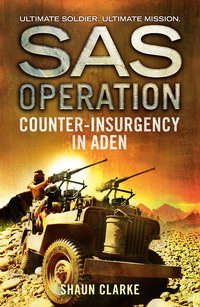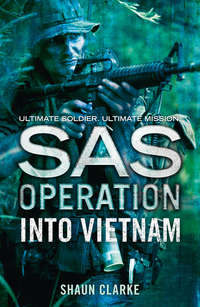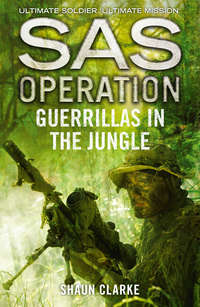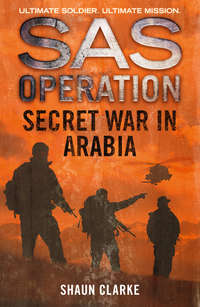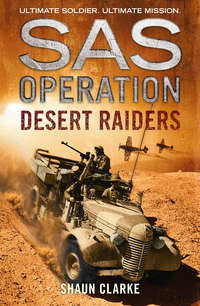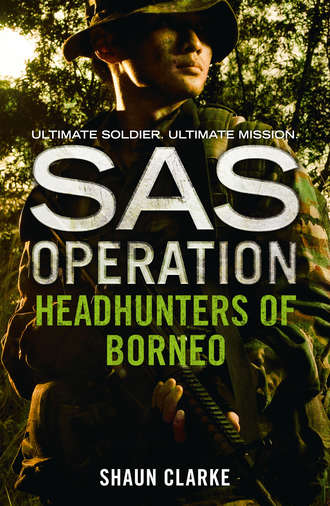
Полная версия
Headhunters of Borneo


Headhunters of Borneo
SHAUN CLARKE

Published by HarperCollinsPublishers Ltd
1 London Bridge Street
London SE1 9GF
www.harpercollins.co.uk
First published in Great Britain by 22 Books/Bloomsbury Publishing plc 1994
Copyright © Bloomsbury Publishing plc 1994
Cover layout design © HarperCollinsPublishers Ltd 2016
Cover photographs © Shutterstock.com
Shaun Clarke asserts the moral right to be identified as the author of this work.
A catalogue copy of this book is available from the British Library.
This novel is entirely a work of fiction. The names, characters and incidents portrayed in it are the work of the author’s imagination. Any resemblance to actual persons, living or dead, events or localities is entirely coincidental.
All rights reserved under International and Pan-American Copyright Conventions. By payment of the required fees, you have been granted the non-exclusive, non-transferable right to access and read the text of this e-book on screen. No part of this text may be reproduced, transmitted, down-loaded, decompiled, reverse engineered, or stored in or introduced into any information storage and retrieval system, in any form or by any means, whether electronic or mechanical, now known or hereinafter invented, without the express written permission of HarperCollins.
Source ISBN: 9780008155032
Ebook Edition © November 2015 ISBN: 9780008155049
Version: 2015-10-15
Contents
Cover
Title Page
Copyright
Prelude
Chapter 1
Chapter 2
Chapter 3
Chapter 4
Chapter 5
Chapter 6
Chapter 7
Chapter 8
Chapter 9
Chapter 10
Chapter 11
Chapter 12
Chapter 13
Chapter 14
Chapter 15
Chapter 16
Chapter 17
OTHER TITLES IN THE SAS OPERATION SERIES
About the Publisher
Prelude
The landscape consisted of dense, often impenetrable jungle, swamps, rivers so broad and deep that they were frequently impassable and aerial walkways created at dizzying heights over the rapids by the primitive tribesmen. Snakes, scorpions, lizards, poisonous spiders and dangerous wild pigs infested the whole area. Though seemingly uninhabitable, the jungle was home to many native settlements, or kampongs, most located either by the river or on a hillside, where the inhabitants tilled the land around them or hunted for fish, lizard, boar, deer, baboon, porcupine or the ever-present snake.
These primitive peoples were Land Dyaks, Ibans, Muruts and Punans, who lived in longhouses made of atap wood, with sloping roofs of tin or thatch. The longhouses were apt to creak balefully on the stilts that had kept them out of the water for decades. Inside they were unhygienic and usually fetid because as many as fifteen families would live in a single dwelling at any given time, using the slatted floor as a communal lavatory. Small and indolent, the natives wore nothing above the waist, regardless of sex, wore their hair long, often tattooed themselves against evil spirits, and lived off rice, tapioca, vegetables and curried meat. Before being killed for eating, their prey was first stunned by a virulent nerve poison borne on a slim bamboo dart shot from a blowpipe.
Early morning in the jungle and swamps was often misty. The strong sun did not break through until at least mid-morning and most afternoons brought a torrential deluge of rain, accompanied by spectacular electrical storms. As a result, the water often rose 30 feet in a single day, slopping and splashing around the stilts of the longhouses, making them groan in protest.
Because certain of the tribesmen, notably the headhunters among them, thought the creaking and groaning were the whispering of bad spirits, they attempted to keep the spirits at bay by stringing up shrunken human heads on the doorposts atop the entrance stairways.
Many of the primitive Iban tribesmen, being experts in jungle tracking, had been employed by the British during the Malayan Emergency of 1948–60 as Army trackers, and were dubbed the Sarawak Rangers. Now, in 1963, having been trained by the SAS, they had been recruited again as an irregular force, the Border Scouts, used mainly as trackers, but also armed and trained as paramilitaries. Increasingly under the command of, and working alongside, the Gurkha Rifles, they were engaged in the ‘secret’ war being waged to protect Sarawak, Borneo, from the forces of Indonesia’s ambitious President Sukarno, who were striking from neighbouring Kalimantan.
Enlisting the aid of the indigenous population, and with the additional reconnaissance and intelligence support of the men of A Squadron, SAS, the Gurkha-led patrols made cross-border raids against the Indonesians, worked at winning the hearts and minds of the jungle dwellers, and set up many Scout posts and observation posts (OPs) in the kampongs and along the densely overhung river banks.
At Long Jawi in Sarawak, 30 miles from the border with Kalimantan, the Gurkhas had established a Scout post consisting of twenty-one trained locals, or Border Scouts, two Police Field Force signallers and a six-man Gurkha team headed by SAS corporal, Ralph Sanderson, on loan to A Squadron from D Squadron. Operating from their own riverside longhouse just outside the village, the members of the border team had spent weeks making friends with the tribesmen in the other longhouses in the area, training certain of them to be armed Border Scouts, and patrolling the valleys, not only for intelligence about Indonesian Army or CCO – Clandestine Communist Organization – troop movements, but also to map out a possible route across the jungle-covered mountains between Sarawak and Kalimantan.
Nominally in charge of such missions, Corporal Sanderson had immersed himself in local culture to such an extent that he was treated by the natives as one of their own and was told all they knew about Indonesian activities in the valley and across the hills, where the build-up of uniformed enemy forces was increasing daily.
Though the SAS were not yet under orders to take aggressive action against such forces, they were allowed to embark on reconnaissance and intelligence-gathering (R & I) missions and, if they sighted the enemy, to inform the Gurkhas and guide them and the armed Border Scouts back across the border. The Gurkhas and Border Scouts would then attack the enemy and make a subsequent hasty retreat back to the Scout post on their own side of the border.
These experiences had filled Sanderson with admiration for the skill and courage of the Gurkhas, but left him with mixed feelings about the Border Scouts. Although fond of the tribesmen, who were superb as trackers and good-natured as comrades, he was convinced that training them as paramilitaries was a waste of time. As well as lacking any sense of discipline, they simply could not learn to handle their weapons properly, and were always pointing them accidentally at one another when they were cocked and loaded. It was the corporal’s belief, therefore, that while the Border Scouts were dependable as trackers, they could not be relied on in a fire-fight and might even be a liability.
Sanderson did not know it, but he was about to be proven right in a most forceful manner.
Just before dawn one day in September 1963 a well-equipped company of Indonesian regulars made an attack by river on Long Jawi, emerging from the early morning mist. The Border Scouts manning the GPMG (general-purpose machine-gun) in a protective sangar at the edge of the river, just outside the Security Forces longhouse and the kampong 500 yards east of it, had been drinking tapai, a potent local cider, the night before and were sleeping soundly at their gun when the Indonesian boats slid into the river bank. The Border Scouts were still sleeping it off when the enemy troops, all wearing jungle-green fatigues and carrying Armalite M16 5.56mm and Kalashnikov AK47 7.62mm assault rifles, slipped off the boats, spread out in a broad firing arc and advanced quietly on the longhouse. While they were doing so, more troops disembarked behind them to set up two 7.62mm RPK light machine-guns spaced so as to cover both lines of retreat from the longhouse.
The first of the Border Scouts was awakened by the snapping of twigs on the jungle floor as the Indonesian troops stealthily approached his sangar. Looking up and seeing two of them practically on top of him, he managed to let out a shrill cry of warning before the enemy guns burst into action with a deafening roar and a combined hail of 5.56mm and 7.62mm bullets tore the sangar apart, turning the Scout into a convulsing rag doll of torn clothing, punctured flesh, exposed bone and pouring blood. The guard next to him suffered a similar fate before even lifting his head, expiring in an explosion of swirling thatch, bamboo and dust from the exploding walls of the devastated sangar.
The Security Forces men also inside the longhouse were rudely awakened by the roaring of the guns outside. First out of his hammock was Corporal Sanderson, who almost in one movement rolled off the bed and landed on his feet on the slatted floor. Picking up his self-loading rifle, he rushed to the veranda while the two Police Field Force signallers and a six-man Gurkha team sharing the longhouse were still struggling to get their wits together. Running at the crouch out through the entrance and along the veranda raised high above the ground, he saw that the Border Scouts who had been sleeping around the longhouse were perishing in a hail of bullets from the Indonesian raiders. The latter were spread out across the clearing between the river and the longhouse and firing their weapons on the move.
The combined roaring of the two Indonesian RPK light machine-guns, fired simultaneously to spray the front of the longhouse, filling the air with flying splinters of bamboo and thatch, merely added to the general bedlam of gunfire, ricocheting bullets, shouting and screaming.
Realizing instantly that there was no hope of defending the longhouse, Sanderson fired a couple of bursts from his SLR. He had the satisfaction of seeing a couple of enemy troops fall down, then he bolted around the corner of the longhouse – the veranda ran right around it – as some Gurkhas emerged from inside, bravely firing their SLRs from the hip. More Indonesians were cut down, but the Gurkhas were punched back by a fusillade of enemy gunfire and collapsed with pieces of clothing and bloody flesh flying from their torn bodies. Even as they were dying, their killers were racing up the steps of the longhouse, still firing on the move.
Now at the side of the longhouse, Sanderson saw one of the two Police Field Force signallers frantically working the radio on the communal table while the other shouted instructions in his ear and the remaining Gurkhas fired their weapons at the entrance. In a futile gesture of defiance, he aimed his SLR through the window-shaped opening in the wall and opened fire as the Gurkhas were cut down by a hail of enemy bullets and the first of the Indonesians burst into the room. The slaughtered Gurkhas were still being bowled backwards by the bullets, knocking chairs and tables over, as the Indonesians shot by Sanderson quivered and collapsed. Those behind them, however, either opened fire on the hapless signallers – blowing the radio to bits and turning one of the signallers into a shuddering quiltwork of shredded cloth and spurting blood – or turned towards Sanderson, trying to locate the source of his gunfire.
The second signaller was still tapping the Morse code keys frantically when a parang swept down through striations of sunlight and sliced off his hand. Before he had time to feel the pain and scream, he was shot through the head with a pistol. The man who had shot him was in turn dispatched by a burst from Sanderson, before the SAS corporal turned away from the window – the other Indonesians too were now aiming at him – and vaulted over the bamboo wall of the veranda as bullets whistled past his head.
A former paratrooper, Sanderson landed on his feet, let his legs buckle, rolled over a few times and jumped back up as a group of Indonesians, one carrying a flaming torch, raced around the corner of the longhouse. A short burst from Sanderson’s SLR bowled over a couple of them, including the one carrying the flaming torch. Falling, the man set fire to himself and started screaming dementedly, his feet frantically kicking up loose soil as some of his comrades tried to put out the blaze.
Meanwhile Sanderson had slipped into the jungle and crept around the back of the longhouse, carefully covering his tracks, while the Indonesians who had seen him plunged on ahead without checking, assuming he would flee in a straight line. As they disappeared into the undergrowth, Sanderson kept circling around the back of the building and saw, through the dense undergrowth, that the Indonesians were setting fire to it. Moving further away, still concealing his own tracks and footprints, he headed for the kampong, to where the sounds of shooting and screaming had spread. Through a window in the undergrowth he saw the Indonesians throwing blazing torches onto the verandas of the simple houses while the natives, men, women and children, fled into the jungle. Having seen enough, and aware that there would be no survivors in the longhouse, Sanderson turned away and headed deeper into the jungle.
When he glanced back for the last time, he saw, through the narrowing window in the undergrowth, that the raiders were looting the kampong and destroying it by fire. When they were finished, he knew only too well, they would withdraw in their boats, leaving nothing but smouldering ruins. As there was nothing he could do to prevent it, Sanderson looked back no more.
He moved at the crouch deeper into the jungle, weaving broadly between the trees, stopping every few minutes to concentrate on the silence and allow any enemy troops in the vicinity to give themselves away by their movement. As he had anticipated, the group pursuing him had broken up to fan out, hoping to find him sooner that way.
One of them materialized straight ahead, his presence made known only by the slight shifting of foliage. Not wishing to give his presence away by firing his SLR, and also in need of rations for what he knew would be a long hike, Sanderson very carefully lowered his SLR to the jungle floor, unsheathed his Fairburn-Sykes commando knife, and inched forward to the shifting, whispering foliage. Rising up silently behind where the foliage was moving, he saw the shoulders and back of the head of the enemy soldier in jungle-green fatigues.
Sanderson stepped forward without hesitation, letting the bushes part noisily, to cover the soldier’s mouth with one hand, jerk his head back and slash across his throat with the knife, slitting the jugular. As the man went into a spasm and his throat gushed warm blood, Sanderson kept his mouth covered and held him even tighter, ensuring that his convulsions did not make too much noise. The dying soldier struggled very briefly, choking on his own blood, and eventually went limp in Sanderson’s arms.
Lowering the dead man gently, almost tenderly to the ground, though this was solely to keep the noise down, Sanderson removed the webbed belt containing his victim’s survival rations and placed the belt around his own body. Then, after going back to pick up his SLR, he headed carefully into the jungle once more.
Four days later, after an epic journey through jungle and swamp, across rivers, through uncharted valleys and over densely wooded hills, using nearly invisible tracks and dangerously swaying aerial walkways, braving snakes, scorpions, wild pigs, charging boar and headhunters, Sanderson – slashed by thorns and palm leaves, bitten by mosquitoes, drained of blood by leeches, a stone lighter and almost starving, his uniform in tatters and his feet badly blistered – stumbled out of the jungle in the early-morning mist of Kuching, Sarawak, and staggered up to the guarded main gates of SAS HQ.
‘I have something to report,’ he croaked to the astounded trooper on duty. Then he collapsed.
1
The briefing took place in the new SAS headquarters, a large house lent to them by the Sultan of Brunei and known as the ‘Haunted House’ because during the days of the Japanese occupation, when it had been used as an interrogation centre, a young British woman had been tortured to death there and was now said to haunt the place. Even so, it was a great improvement on the makeshift headquarters the SAS Squadrons had been using previously, containing as it did a communications centre (COMMCEN), sleeping quarters, showers, recreation room, and other rooms such as the lecture hall where the briefing was given.
Leading the session was the Squadron Commander, Major Patrick ‘Paddy’ Callaghan, who felt completely at home in Borneo after having served his stint in Malaya during the Emergency. Also, though many SAS officers felt ill at ease when first confronting their notoriously critical troopers – it was the SAS NCOs, after all, who picked the officers during Initial Selection and thereafter judged them sternly – Callaghan felt comfortable because of his lengthy experience with the SAS since its inception in World War Two.
In fact, Callaghan had been one of the very first officers to work with the regiment’s founder, Captain David Stirling, alongside the Long Range Desert Group in North Africa. After a few years back with his original regiment, 3 Commando, he had been one of the first chosen to take part in the regiment’s re-formation during the Emergency in Malaya. From there he had returned to Bradbury Lines, then still located at Merebrook Camp, Malvern, where he had worked with his former Malayan Squadron Commander, Major Pryce-Jones, on the structuring of the rigorous new Selection and Training programme for the regiment, based mostly on ideas devised and thoroughly tested in Malaya. Promoted to the rank of Major in 1962, shortly after the SAS had transferred to Bradbury Lines, Hereford, Callaghan had been pleased to be offered the leadership of D Squadron just before its assignment to the Borneo campaign in 1964.
It is possible, therefore, that he felt even more at peace with the world because some of his former troopers, including the so-called ‘troublemakers’ Pete Welsh and Alf Laughton, both since promoted to corporal, and Corporal (now Sergeant) Richard Parker, were here with him, impatiently waiting for the briefing while wiping sweat from their faces and swatting away swarms of flies and mosquitoes.
‘Piggin’ fucking flies and mosquitoes,’ Alf Laughton said. ‘They only send me to countries filled with the bastards. It’s their way of tormenting me and driving me loopy.’
‘You buzz like a fly and whine like a mosquito,’ his good mate, Pete Welsh, replied sardonically. ‘That’s why they send you to places like this. They think they’re sending you home.’
‘Fuck you an’ all,’ Alf grunted.
‘All right,’ Callaghan said firmly, picking up a pointer, tapping it noisily on his lectern, then pulling the cloth covering off the blackboard behind him to reveal a large map of Borneo. ‘Pay attention now. This,’ he continued when the men had settled down, ‘is what we’re protecting.’ He tapped the word ‘Sarawak’ with his pointer, then ‘Kuching’ and ‘Brunei’ and finally ran the pointer along the red-dotted line marking the border. ‘Regarding the required background…’
He was interrupted by the customary moans and groans, since this was always the least popular part of an initial briefing, when the men had to listen, rather than taking part in the SAS custom of the ‘Chinese parliament’, or free exchange of ideas between officers and men.
‘I know you all find this boring,’ Callaghan said, grinning, ‘but it’s necessary, so kindly be quiet.’ When they had settled down again, he continued: ‘Brunei is one of three British dependencies in Borneo; the others are the colonies of North Borneo, now known as Sabah, and Sarawak. These territories, though extensive, represent only a quarter of the island. The rest belongs to Indonesia, whose head of state, President Sukarno…’
‘The Mad Doctor!’ Alf bellowed, winning a few laughs. With flaming red hair and a face pitted by acne, the corporal looked like a wild man. He had served twice in Malaya. The first time was in 1953 with the King’s Own Yorkshire Light Infantry – when he had spent most of his time having a good time in Penang, rather than fighting. The second was in 1958, when, as a recently badged SAS trooper, he had been forced to stop fooling around and, instead, faced the horrors of the Telok Anson swamp alongside Sergeant Parker, Corporal Pete Welsh and a good many other, now dead, friends. Once considered a troublemaker and almost thrown out of the SAS, Alf had been saved by his exemplary behaviour in that dreadful swamp and went on to become a ruthlessly efficient member of the Directing Staff at 22 SAS Training Wing, Hereford. Now considered an ‘old Malayan hand’, he was indisputably a good man to have in Borneo.
‘Yes,’ Callaghan agreed, acknowledging the nickname bestowed by British troops on Indonesia’s ambitious leader. ‘The Mad Doctor…Anyway, on 8 December 1962 an internal rebellion in Brunei was organized and led by a young sheikh named Azahart, who wanted to unite the three dependencies. This he did by launching simultaneous guerrilla attacks against police stations, government buildings and other strategically important targets. Obliged to put this revolt down, the British quickly sent in troops stationed in Singapore, including the Queen’s Own Highlanders, the Royal Marine Commandos and the Gurkhas. Eight days later the rebellion was over and most of the rebels had fled into the jungle.’
‘Where they remain to this day,’ Pete Welsh said.
‘More or less,’ answered Callaghan.
Another old Malayan hand, Londoner Pete Welsh was an explosives expert who had been trained at No 101 Special Training School Singapore during World War Two, transferred as a sapper to 3rd Corps, with whom he had fought the Japanese during the occupation, then finally became an SAS trooper with D Squadron, returning to Malaya to take part in the Emergency with Alf Laughton, as well as some other good friends, who were killed in the Telok Anson swamp. Like Alf, regarded at that time as troublesome, he had, just like his mate, been matured by his experiences in the swamp and emerged to become an exemplary member of the Directing Staff at 22 SAS Training Wing. He was glad to be in Borneo, back in the thick of things.
‘Which brings us to the Mad Doctor,’ Alf said.
‘Correct,’ Callaghan replied. ‘President Sukarno, a great fan of the Japanese, is now driven by the dream of unifying south-east Asia under a single leadership – naturally, in this case, his own – and has cast his greedy gaze on Borneo. For this reason, when Britain backed the proposed formation of a new political entity in the region, comprising Malaya, Singapore, Sabah, Sarawak and Brunei, Sukarno opposed it, did everything in his power to wreck the plan and, in December 1962, just after the Brunei Revolt had been put down, infiltrated insurgents from Kalimantan into Borneo. When, in September 1963, Sabah and Sarawak were officially incorporated into the new Malaysian Federation, Sukarno’s forces dramatically increased their activities, with more attacks along the border. The British response was, again, immediate: to fly a force of Malaysian, British and Commonwealth troops in to contain the insurgents. You men are a further part of that force.’




